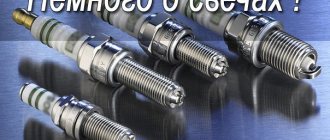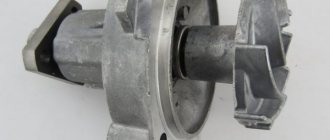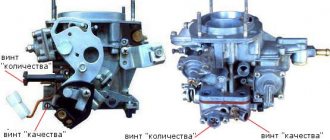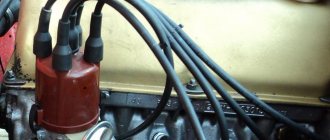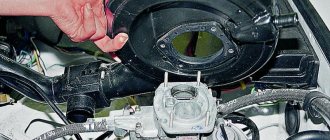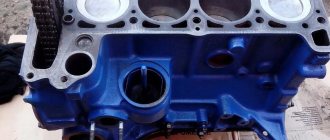Among car enthusiasts, there is a lot of debate about what will happen if a Solex carburetor is installed on a VAZ 2106, from a VAZ 21083. What improvements will appear in the technical characteristics of the engine, or vice versa, what will have to be sacrificed. Let's look at what installing a Solex carburetor on a VAZ 2106 will give.
Carburetor 2106
The standard option used on the Six engine is the “Ozone” sample. This is a two-chamber carburetor, with a falling air flow, emulsion type. The technical characteristics of the engine, when running, produced 75 horsepower, and the maximum speed was 155 km/h. Acceleration time to hundreds is 16 seconds.
The engine response is good, but when you press the gas pedal sharply, the car first chokes and then starts to move. This was explained by the fact that in the Ozone float chamber, the fuel level was insufficient, and during sharp acceleration there was not enough of it.
VAZ 2106 car owners were racking their brains over the question of which carburetor is better to install so that the engine's throttle response increases, while having minimal losses. Most opinions agreed that installing a Solex with a VAZ 21083 would be the best option.
see also
Comments 68
Since now I’m having complete troubles with the carb, I’m thinking about replacing it with 21053-1107010-20, please tell me since this carb has a gas drive on the other side. Is it possible to screw sector 08 there since I now have my own carb 2106 converted to cable gas.
hi, I won’t tell you, it was given
Regarding EPHH. It is best to choose a jet that will suit you in terms of performance (if the standard one suddenly doesn’t suit you for some reason) and no needle biting. In terms of connection - according to the circuit from the switch (if BSZ) - the most correct option. From the coil either in an emergency (wire break) or during contact ignition. Correctly connected EPHH, albeit slightly, nevertheless reduces consumption. When the gas is abruptly released, it closes the XX channel and prevents the vacuum created in the throttle space from greedily sucking out the fuel. Verified. Carburetor adjustment: 1. NO flags No. 4 nafik are needed, standard No. 7 works perfectly and correctly. 2. We install the elephant correctly (after maybe fucking for a couple of hours) 3. We stock up on jets of different sizes and select the optimal sizes for OUR engine. From “tuning” it really helps (during the tuning process) to drill holes in the upper part so that the jets can be changed without removing the carb. Sticks for Lyulya Kebab help in removing the jets and everything is done in a few minutes. In general, there is comrade Evgeniy Travnikov (WerWolf-DVS), who made a stunning series of videos about Solex with theory, practice and advice. On YouTube channel ICE Theory. After watching these videos, questions about Solex no longer arise.
On mine, replacing the Weber with a Solex, I also installed cable throttle. Some people think this is unnecessary, but I liked it better than the old inadequate traction.
Thanks for the good advice on finding a carburetor. We should try to find one too. Only one thing is interesting: which jets are best installed on 21061 (1.5) so that the flow rate is closer to optimal?
Immediately use the jets according to the book, and then use the butt meter to select a comfortable flow/injection ratio. Even the same engines behave slightly differently and what is good for one is not so good for another. I advise you to pay attention to 21081 near Tavria. Once in my Moskvich it turned out to be the most economical and at the same time very cheerful. How this will show itself at a VAZ - I don’t know.
What is the fuel level in the float chamber? Make it about 27-29 mm. As a last resort, take another carb from a friend and check how it goes. Is there any air leakage anywhere near the stove?
Save your friend! I don’t know where to write anymore... I have a seven 1.6 and this carb is 21053-20, I’ve been driving for 1.5 years already, the whole car has been serviced, the consumption does not drop below 11, and this is only in a very quiet mode (((When I got to the carb, I noticed that the jets there are from carb 21083, which seems to be generally under 1.3 and decided to look for relatives (last column in the photo). Only there were none left anywhere. 140 air never found, I only have 145 or 150, I installed them and went for adjustment. The carburetor guy just opened the carb and asked, where are the jets, what were there? I showed him what was there and he installed them again, no matter how I argued with him, he convinced me that this was the best option... there’s also a pump from the Niva into one chamber at 45. What do you think about my situation? and what was your consumption with this carb, so that I can navigate?
Haven't figured out the carb yet? 11 liters is most likely due to the Nivovsky spout; because of it, consumption increases quite well. If you can’t find a 140 jet, try putting in a 145, if you feel it’s getting lean, put in a 110 fuel jet and you’ll be happy. Right now I generally have 112.5 fuel and 150 air, but this is due to the fact that the head is bored out. But from 83 there is no point in setting it. So he's such a shitty carburetor guy
Carburetor VAZ 21083
The VAZ 21083 car was equipped with a Solex carburetor. Just like Ozone, it was intended for 1500 cc engines. Its float (primary) and secondary chambers were slightly enlarged, and the fuel level was correspondingly higher. Solex provided the Eight with the following technical indicators: power - 70 hp, rated speed - 155 km/h. At the same time, acceleration to 100 km/h took 15 seconds.
The characteristics are not particularly better than those of the VAZ 2106. But this is explained by a different engine structure. And here’s what the “Six” will show us, when equipped with this carburetor.
Removing and installing the carburetor
- We remove the hose that takes warm air from the pipe. To do this, you will need to first loosen the clamp.
- Remove the air filter.
- Cover the carburetor with a clean, lint-free cloth. This is necessary so as not to accidentally drop the filter housing mounting nuts into the float chamber.
- Unscrew these nuts.
- We remove the plate.
- Remove the hose from the crankcase.
- Remove the filter housing.
- Remove the fuel hose.
- Remove the tip of the solenoid valve.
- Unscrew the bolt that secures the drive cable.
- Unscrew the cable screw.
- Carefully remove the cable.
- Remove the gas exhaust hose from the crankcase.
- Removing the ignition regulator hose
- We remove the spring.
- Unscrew the nuts securing the carburetor. You need to act very carefully, not to use too much force. The fact is that the mating plane of the device is made of soft metal and can easily be damaged.
- The carburetor can be removed from the engine.
Installation of a working device is carried out in reverse order according to the same scheme.
This article is part of a series of 9 lessons dedicated to 7 carburetors. To view all nine lessons, follow the link: https://7vaz.ru/chto-takoe/karbyurator.html
Installation procedure
The Solex carburetor is absolutely suitable for mounting on the VAZ 2106 engine. Since the device itself is different, you will need to purchase some additional parts in order for the installation to be successful and the engine to work properly. The parts list includes the following items:
- 2 paronite gaskets and 1 paper;
- 1 meter of hose for fuel supply;
- Carburetor, always with a slide;
- A set of keys, screwdrivers and other locksmith supplies.
Now, you can get to work.
Before installing the Solex on a VAZ 2106, clean the area where the Ozone carburetor connects to the engine. This is done so that when removing, debris does not get into the engine. Next, disconnect all the hoses and cables. Next, unscrew the fastenings and remove the “Ozone” from the engine. Before installing the carburetor from the VAZ 21083, clean the mounting location. Afterwards, apply sealant and lay the gasket. The gaskets should be in this order: thin, thick and thin.
When the seat is ready, disassemble the Solex into two parts. This will make it easier for you to install it. First of all, install the rocker from the carburetor VAZ 21083 to 2106, as this is the key element required to begin the installation. You can already install the Solex on it.
Now, connect all the cables and hoses. We start with the throttle cable. It must be set to the required length, which is enough to connect it. Next in line is the fuel system hose. Before installing it, it is worth considering that on the VAZ 21083 it is longer than on the 2106, so you will need a pre-prepared meter hose. Place one of its tips on the outlet of the fuel system, and the second on the inlet to the carburetor. Before putting on the second end, it is better to cut it so that it does not dangle freely in the engine compartment. Also, remember, the longer the hose, the more fuel it will contain, and therefore the weight. This can cause it to become disconnected and possibly even cause the engine to catch fire.
Connecting and setting up the rods
Next, we connect one end of the return flow to the fine filter, do not forget to install a valve in it. Place the other end on the carburetor. We put all the springs in their places (they do not need to be replaced with new ones). Once all the hoses and cables are in place, you will need to worry about the idle speed. To do this, install a solenoid valve.
The final touch is to put on the top part of the carburetor and tighten the fastening nuts. Now, your Solex is ready for use.
Modification of the pneumatic drive of the throttle valve of the second chamber of carburetor 2105, 2107 Ozone
The pneumatic drive of the throttle valve of the second chamber of the carburetor 2105-2107 Ozone ensures its timely opening at power modes, which ensures the flow of additional volume of fuel mixture into the engine cylinders.
This entails an increase in the power and response of the car’s engine, and an improvement in its dynamics when driving in higher gears. Therefore, it is worth carrying out a simple modification of the Ozone carburetor and once and for all you will get rid of possible problems and somewhat revive the car engine. Purpose of revision
By changing the scheme for supplying vacuum to the membrane device of the pneumatic drive, achieve clearer and more timely operation of it, thereby slightly increasing engine power and accordingly improving vehicle dynamics.
Required Tools
1. Phillips screwdriver.
2. Shilo.
3. Drill.
4. Drill 3 mm.
Preparatory work
1. Remove the carburetor from the car engine.
2. Disconnect the pneumatic drive housing.
To do this, use an awl to pry up and remove the lock washer on the rod, and use a Phillips screwdriver to unscrew the two screws securing the pneumatic drive housing to the carburetor.
Removing the throttle valve pneumatic drive housing of the second chamber of the carburetor 2105, 2107 Ozone
3. Disconnect the lower part (throttle valve block) of the carburetor.
We remove the spring, unscrew the two screws securing the lower part with a Phillips screwdriver, disconnect and remove the curved rod from engagement with the lever.
disconnecting the lower part (throttle valve block) of the carburetor 2105, 2107 Ozone
What you need to know
Vacuum is supplied to the pneumatic drive housing through two channels from both chambers of the carburetor. At the moment when the throttle valve of the first chamber opens, a vacuum enters from the first chamber, the throttle valve of the second chamber is still closed at this time and instead of a vacuum, air enters the channel from the second chamber, reducing the magnitude of the vacuum.
As a result, the valve of the second chamber opens with a delay, since the pneumatic drive opens it reluctantly. Hence the reduction in power and failures.
On the contrary, when releasing the “gas” at high speed, it is necessary that the throttle valve of the second chamber closes quickly and without delay. This requires stopping the supply of vacuum to the pneumatic drive housing. But, again, this happens with a delay, since the throttle valve of the first chamber is already closed and there is no vacuum from the first chamber, but from the second chamber, with the throttle valve still open, it comes, because at this moment a huge volume of air in an engine running at high speeds.
In this case, the pneumatic drive closes the valve with a delay, allowing excess fuel to enter the cylinders; instead of slowing down, the car, on the contrary, makes an unpleasant jerk forward (“pickup”). Knowing these features and the operating diagram of the pneumatic drive, we will do the following.
Modification of the pneumatic drive of the carburetor throttle valve 2105, 2107 Ozone
1. At the bottom of the channel for supplying vacuum to the pneumatic drive housing leading to the second chamber of the carburetor, a jet is visible.
The hole in it must be sealed.
jet in the channel for supplying vacuum to the pneumatic drive housing from the second chamber
To do this, you can use cold welding, a piece of tin, lead, or, as a last resort, a drop of sealant. We hammer the hole in the nozzle carefully so that the seal does not pop out later.
2. Turn the carburetor over, find the jet in the vacuum supply channel from the first chamber and carefully drill it out with a drill with a 3 mm drill.
jet that needs to be drilled out
3. Blow out the carburetor from chips and contaminants and reassemble it.
As a result of the modification, vacuum will enter the pneumatic drive housing only from the first chamber of the carburetor through an expanded (without jet) channel. This ensures timely, without delay, opening of the throttle valve of the second chamber.
And, conversely, when the throttle valve of the first chamber is closed, the throttle valve of the second chamber will close after it, without delay, causing a decrease in the fuel mixture entering the engine cylinders and thereby reducing the speed of the vehicle.
More details about the modification of the pneumatic drive with a description of some details in the article “Refinement of the pneumatic drive of the throttle valve of the Ozone carburetor 2105, 2107: details.”
Notes and additions
— It should be noted that the above modification of the pneumatic drive makes sense only if its channels, housing and diaphragm integrity are tight. The throttle axis should rotate easily, without jamming, and also easily return to its original position with a spring on the axis.
— How to check the operation of the pneumatic drive of the throttle valve of the second chamber of the carburetor 2105-2107 “Ozone”, its structure, principle of operation is described in detail on the page “Pneumatic drive of the throttle valve of the carburetor 2105-2107 Ozone”.
— In some cases, it makes sense to completely convert the pneumatic drive of the throttle valve of the 2nd chamber of the carburetor into a mechanical one and forever forget about the insufficient throttle response of the engine when it is opened. Read more: “Refinement of the throttle valve drive of the second chamber of the Ozone carburetor.”
— Along with modifications to the pneumatic drive, modifications are usually made to the return spring bracket of the throttle valve locking lever of the second chamber of the carburetor.
Five more articles on the site on tuning and repair of carburetors
Settings
Before you start operating the carburetor from a VAZ 21083 on a VAZ 2106, it must be configured.
In order for the mixture to be prepared better and for you to make adjustments easier, park the car on level ground, without slopes. Start the engine and test it at high and low speeds. This will let you know in which mode the engine receives a normal mixture, and in which it requires adjustment.
After running the engine for a while on the new carburetor and filling its chambers with gasoline, you will need to check what a constant level is in them. To do this, remove the cover from the carburetor, and using a caliper, measure the distance from the fuel level to the top edge of the float chamber. It is best if the level is from 23 to 25 mm. In this case, the carburetor will not flood the spark plugs and stall at idle.
To adjust the fuel level, simply bend the float in the desired direction (up or down). After each change in position, check the resulting distance. When the float is set, assemble the device and begin adjusting the quality and quantity of fuel.
On a VAZ 21083, the correct mixture is obtained with the following settings:
- Quantity screw: 1.5 – 2 turns;
- Quality screw: 4 – 4.5 turns.
After installing it on the VAZ 2106, it is necessary to configure the device after the engine has run at all speeds. And also, the fuel must be heated to operating temperature.
Replacing jets
You can't just change the jets. you must understand why and how this is done. Therefore, you should familiarize yourself with what you have to work with. Fuel jets supply a certain amount of gasoline to the engine, which is drawn there thanks to diffusers. The amount of gasoline drawn through the nozzles directly depends on the engine size. It follows that for proper fuel consumption it is necessary to install smaller jets on a larger engine volume.
Adjusting the fuel level
Select jets first for fuel, and then for air. Do not touch the secondary Solex chamber until you select the jets for the first one. The easiest way would be to find a factory Solex, which already has the required jets designed for a similar engine size. However, do not forget that not all Solexes are suitable for VAZ engines.
For some, the Solex will work immediately, while for others it will not work at all. Therefore, you don’t need to think that you can take jets for your Solex from any other carburetor of a similar volume. Find one that is suitable for Zhigulis, and buy the same jets as on it. So, Solex 21053 for classic is installed and configured. Don't forget to clean it regularly to ensure quality performance.
Bottom line
After installation, the characteristics of the Six engine will acquire several pros and cons.
The advantages are that the engine will be more responsive, the maximum speed will increase (up to 160 -165 km/h), and the acceleration time to the first hundred will be reduced (instead of 15 seconds - 13). The modernization will not significantly affect the rated power, increasing it by 5 - 10 hp.
The only downside is fuel consumption. With normal, non-economical driving in the urban cycle, it will increase by 1 - 1.5 liters.
The general conclusion is this: installing this carburetor is a necessary thing, because for the price of 1 - 1.5 liters per 100 kilometers, you will get more driving comfort.
Lada 2105 Workhorse › Logbook › Carburetor DAAZ 21053-1107010-20 “SOLEKS”
I thought for a long time about the Solex
for classics, I compared prices, there is DAAZ 21053-1107010-20 and PEKAR K178I.21053-1107010-20, I almost bought PEKAR, but DAAZ
unexpectedly dropped in price
from 3990r to 3790r, and then completely to 2990r
so what did I know about carburetors for classics with an engine capacity of 1.5-1.6:
1) for classics (2105, 2107, 2104) with an engine volume of 1.5-, 1.6, a SOLEKS type carburetor is intended 21053-1107010-20
- no options! (no 083 - catch the crap, catch it!)
2) consumption with a SOLEKS carburetor compared to a standard carburetor 2107-1107010 will be MORE!
, the car is more responsive, but you have to pay for everything - on average 0.5 liters more per 100 km
I didn’t install it myself - I installed it without an economizer, I don’t know yet whether it’s better or not
I recommend
to watch on Youtube the blog of carburetor engineer from Dmitrovograd
Nail Poroshin
- very interesting! Video blog of Nail Poroshina (Dmitrovograd)
so that Solex doesn't get dirty
(they have such a disadvantage) you can install a mesh and not have any problems at all, as well as a cut 4th “cam from Nail”
1) the car has become a little faster 2) you need to warm up less to get moving 3) yes, the car is responsive! (smooth ride when changing gears) 4) even the consumption seems to have decreased, even without an economizer - I think the standard carb was a little clogged and ate gasoline very well
and the result: an injection engine is not needed, Solex-a 21053-20 is enough for the ears
I recommend installation!
continuation of a story
I drove for a day, I looked at the idle speed of 1000 somewhere, turned it up to 750, and the next day the idle speed disappeared altogether, as soon as the car stopped at the intersection... I turned it back up... but the idle speed floated 850-1200, so I drive (it was decided - the plug flew out in manifold, plugged it in with a new one and carefully set the speed with the screw - everything was fine)
PLEASE COMMENT on the installation, how should it be done?
Issue price: 3,500 ₽
How to adjust a Solex carburetor
Only a properly adjusted carburetor can ensure maximum engine performance and efficiency. For the most accurate adjustment, experts recommend installing the car on a level surface - this promotes better preparation of the air-fuel mixture. First, start the engine and test its operation at different speeds. This way, you can determine in which mode the normal mixture is prepared, and in which adjustment is required.
The following guide will tell you how to set up a Solex carburetor on a VAZ-2106:
- Once you have started the engine, let it run to warm up to operating temperature.
- During warm-up, the float chambers will fill with fuel, which will allow you to check its level. To do this, you need to remove the cover from the carburetor and measure the distance between the upper edge of the float chamber and the level of gasoline in it. Use a caliper. The recommended level at which the spark plugs will not flood and the engine will not stall at idle is 23–25 mm. If the obtained values do not correspond to the norm, you will have to adjust the carburetor regarding the fuel level.
- Adjustment of the gasoline level in the float chambers is carried out by bending/bending the float up or down.
- Once the setup and control measurements are complete, replace the cover and proceed to the next step.
- Next, adjusting the Solex carburetor on the VAZ-2106 consists of adjusting the idle system. If you purchased a new unit for installation, then the optimal settings for preparing a combustible mixture at idle speed are as follows:
- The mixture quantity screw must be unscrewed 1.5–2 turns;
- The mixture quality screw should be unscrewed 4–4.5 turns.
This concludes the guide on how to adjust the Solex carburetor on a VAZ-2106 after installing it. However, in conclusion, it should be said that the “sixth” model with this unit will inherit both important advantages and noticeable disadvantages. The first includes improved engine response and a top speed increased to 165 km/h. The modernization also has a positive effect on acceleration - the car will be able to reach the first 100 km/h two seconds faster. As for the disadvantages, there are only two of them - increased fuel consumption and increased requirements for the quality of gasoline use. In general, by installing a Solex carburetor on a VAZ-2106 with your own hands, you will get more comfortable driving, the cost of which is not so high.

